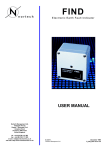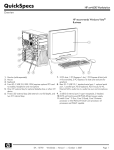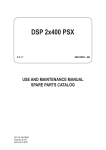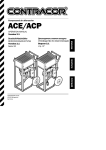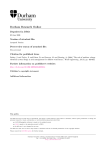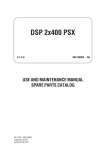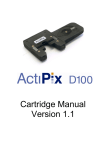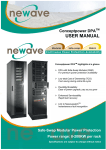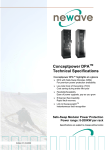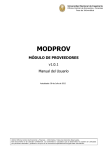Download SPi-EF SPi-OCEF - Fundamentals Ltd
Transcript
SPi-EF and SPi-OCEF Fault Passage Indicators USER MANUAL Nortech Management Ltd. Tadcaster House, Keytec 7 Business Park, Kempton Road, PERSHORE WR10 2TA Untied Kingdom tel: +44 (0) 8700 111 992 fax: +44 (0) 8700 111 992 e-mail: [email protected] web site: http://www.nortechonline.co.uk E&OE ©Nortech Management Ltd Revised November 2002 D_061_0279 issue 2.02 SPi-EF and SPi-OCEF - USER MANUAL PAGE 1 OVERVIEW This document describes the Operation, Installation and Maintenance for two fault passage indicators: SPi-EF (Self Powered Earth Fault indicator) SPi-OCEF (Self Powered Over Current and Earth Fault indicator) The SPi unit is connected to a local AC supply which is used to maintain operational readiness. On removal of this local supply an internal power source supports the operation and any indications of the SPi. When the local AC supply is restored after a period of “self powered” operation the SPi replenishes the standby internal power source. Indication for faults is by flashing Hyper-Bright LED for and additional electrical indication from auxiliary contacts. THERE IS NO BATTERY IN EITHER THE SPi-EF OR THE SPi-OCEF. Also in the range is the SPi-OCEF Programmable which provides additional functionality. CONTENTS Section Page 1. General Description 2 2. Operation Fault Definition Fault Indications Fault Scenarios 3 3. Current Transformers 8 4. Switchgear Earthing 10 5. Specification 11 6. Installation Physical 13 Wiring Enclosure Bracket ©Nortech Management Limited 7. Operational Checks SPi-EF SPi-OCEF SPi-OCEF Injection Test 16 A Appendix 18 document reference D_061_0279 issue 2.02 SPi-EF and SPi-OCEF - USER MANUAL 1. PAGE 2 GENERAL DESCRIPTION The SPi range of fault passage indicators is designed for application to distribution networks where manually operated or automated switchgear is installed. When current above a threshold level is detected the indicator operates alarm contacts for remote indication and illuminates an integral high brightness Light Emitting Diode (LED). Indicators strategically placed in the distribution network aid identification of a faulty section of network as shown in fig.1A where a fault occurs at position A. SOURCE NO TRIP Fault past these points NO A Fig.1A The SPi-EF and SPi-OCEF indicators are compact units contained within a high strength polycarbonate case and sealed within a waterproof compound. The SPi-EF indicator, fig.1B, is used with a core balance current transformer (CT) mounted around a distribution cable at the switchgear end. When earth current is detected in any phase conductor, the SPi-EF unit measures the current and if a fault is calculated, an ultra bright LED is flashed. For a permanent fault the indicating period is 3 hours. For a transient fault the indicating period is 24 hours. In each case contacts are operated for remote alarms. The power supply to the indicator is taken from the local distribution network under normal system conditions. When supply is detected the indicator charges over a short time and is available for fault detection and indication during and after a fault occurrence for a period of up to 6 hours for a permanent fault. ©Nortech Management Limited document reference D_061_0279 issue 2.02 SPi-EF and SPi-OCEF - USER MANUAL PAGE 3 Fig.1B SPi indicator (SPi-EF shown) In practice the measurement of true fault current by use of a core balance CT requires consideration to the following: - Any external earth wire connections used with distribution switchgear must be routed carefully such that the cable core current can be accurately measured - During the fault clearance period when the device is measuring, capacitive currents can flow into the fault location from both ends of the feeder. The indicator must discriminate between true fault current and short time capacitive discharge current. - Strong magnetic fields produced by external current flowing in earthwire connections in close proximity to the indicator or core balance CT must not cause operation of the indicator. - Core balance current transformers used must be unaffected by external fault currents. The SPi range of indicators has been designed to operate under these most onerous conditions and give reliable indications. The SPi-OCEF indicator, is used with either 3 phase mounted CT’s or alternatively, 2 phase mounted and one core balance CT. The indicator monitors for phase to phase and earth faults and operates to give remote alarms and local indications as for the SPi-EF indicator. ©Nortech Management Limited document reference D_061_0279 issue 2.02 SPi-EF and SPi-OCEF - USER MANUAL 2. PAGE 4 OPERATION The SPi is powered from the local mains supply under system normal conditions. When first energised the indicator is ready for fault indication after 60 seconds. If supply is lost and then restored within 30 minutes the indicator is ready for fault indication after 10 seconds. Measurement of earth current is made every 1mSec. When current above the threshold setting of the indicator is measured a fault calculation is initiated. The algorithm used for fault measurement allows the indicator to grade with the minimum settings likely to be used by the source protection relays and at the same time avoid possible mis-measurement due to capacitive charge currents. The indicator characteristic is shown in App.A against typical source protection minimum settings. 2.1 Fault Definition The indicator determines a fault as follows: IF supply was on 500mS before the current exceeds the threshold set point AND the current exceeds the characteristic criteria (app. A) AND the supply is off within 500mS after the current dropping below the threshold set point THEN a fault is set Fault Definition indeterminate Supply Current 500msec maximum 2.2 Curve Time achieved 500msec maximum Fault Indication A fault is indicated on the SPi by an ultra-bright LED, flashing at an interval of approximately 1.5 seconds. For remote alarms, volt free contacts are closed at the start of the indicating period. The alarm contacts can be specified fleeting (2 seconds), or permanently closed until the end of the indicating period. The device will indicate for both transient and permanent faults. The indications are as follows: - Transient Fault, if fault current is measured and the mains supply is restored in less than 3 hours the high intensity red LED will flash repeatedly for 24 hours unless reset - Permanent Fault, if fault current is measured and the mains supply is still off after 3 hours the high intensity red LED will flash repeatedly for 3 hours unless reset - Trigger level, the fault LED will indicate when the threshold operating current is reached and until the curve time is achieved If a transient fault is being indicated and a new fault is detected, all indicators will update and indicate for the new fault situation. A test/reset button located on the front of the SPi can be used to test the functionality of the indicator or to reset a fault indication. ©Nortech Management Limited document reference D_061_0279 issue 2.02 SPi-EF and SPi-OCEF - USER MANUAL 2.3 PAGE 5 Fault Scenarios The action of the indicator under various fault situations is shown in more detail below: - Transient Fault Supply Fault Current Fault Sensing 3 min Indication 24 hr Relay Fleeting or latched option On fault detection the indicator will flash to indicate fault passage. After a valid fault has been set and providing supply is restored, no fault measurements are taken for 3 minutes. If the line voltage is restored within 3 hours the unit will indicate for a total of 24 hours and at the same time monitor the circuit for further faults. Permanent Fault – supply restored before 3 hour time out period Supply Up to 3 hours Fault Current Fault Sensing Indication 24 hr Relay Fleeting or latched option If, following the fault, supply is not restored the unit will indicate for 3 hours. If supply is restored during this period the unit will indicate for 24 hours and monitor and update for further faults. ©Nortech Management Limited document reference D_061_0279 issue 2.02 SPi-EF and SPi-OCEF - USER MANUAL PAGE 6 Permanent Fault – supply restored after 3 hour time out period Supply More than 3 hours Fault Current Fault Sensing Indication 3 hours Relay Fleeting or latched option If, following a fault, supply is not restored within 3 hours, the unit will reset. Trasnsient Fault followed by a Permanent Fault past SPi Supply Fault Current Fault Sensing 3 mins Indication 3 hours Relay Fleeting or latched option If, when indicating for a transient fault, fault current is measured, the unit will fully update for the new fault. ©Nortech Management Limited document reference D_061_0279 issue 2.02 SPi-EF and SPi-OCEF - USER MANUAL PAGE 7 Trasnsient Fault followed by a Transient Fault past SPi Supply Fault Current Fault Sensing 3 mins 3 mins Indication 24 hours Relay Fleeting or latched option If, when indicating for a transient fault, fault current is measured and the line voltage is immediately restored, the will indicate for a further 24 hours and fully update for any further faults. Trasnsient Fault followed by a Permanent Fault BEFORE SPi Supply Source CB open Fault Current Fault Sensing 3 mins Indication Relay Fleeting or latched option ©Nortech Management Limited document reference D_061_0279 issue 2.02 SPi-EF and SPi-OCEF - USER MANUAL 3. PAGE 8 CURRENT TRANSFORMERS The SPi-EF is designed for use with a 60/1 core balance CT having a minimum rating of 1.5VA and an accuracy of 10% up to 4 times primary current (10P4). With this CT the threshold current is 50Amps. If other ratio CT’s are used the operating threshold is: 0.833 x P/S Where P is CT primary current rating and S is CT secondary rating. The SPi-OCEF is designed for use with 3 phase mounted 400/1 CT’s, fig.3A, or alternately 2 phase mounted 400/1 CT’s and a single 60/1 core balance CT as used with the SPi-EF indicator, fig.3B. Note that when a core balance CT is used, the phase mounted CT’s must always be connected to terminals 1 and 3 on the SPi indicator. At the rear of the indicator two switches allow the overcurrent threshold level to be set to 600A or 250A and the CT arrangement to be set (3 phase mounted CT’s or 2 phase mounted and 1 core balance CT. The earth-fault threshold level is a nominal 50A. If an existing core balance CT is used the earth-fault threshold level will be dependent on the CT primary rating. OC1 OC2 EF 1 3 5 E 7 SPi-OCEF 3 x Phase mounted CT’s Switchgear C11 C31 C51 C90 C70 Alternative earthing arrangement Fig.3A Connections using 3 phase mounted current transformers ©Nortech Management Limited document reference D_061_0279 issue 2.02 SPi-EF and SPi-OCEF - USER MANUAL PAGE 9 OC1 OC2 EF 1 3 5 E 7 SPi-OCEF 2 x Phase mounted CT’s Switchgear C11 C31 C70 C90 C71 Core Balanced CT Alternative earthing arrangement Fig.3B Connections using 2 phase mounted CT’s and one core balance CT Important note: Phase mounted current transformers must be securely mounted around the cable cores at a point where the core earthed screen passes through and beyond the CT. The jointing procedure for the cable termination should specify the method to be adopted in order to ensure electrical stress control. The secondary wiring must be earthed, as shown by figure 3A and 3B. ©Nortech Management Limited document reference D_061_0279 issue 2.02 SPi-EF and SPi-OCEF - USER MANUAL PAGE 10 4. SWITCHGEAR EARTHING Earth fault current is returned to source through the path of least resistance. When the fault occurs in a cable system, the majority of return current will flow through the cable sheath, thus resulting in a null output from a core balance CT, as shown in figure 4A. Fault Current Return Fault Current SPi MINIMAL OUTPUT Fig.4A This effect can be prevented if the cable earthing connection between the cable and adjacent switch is routed through the core balance CT, figure 4B. Fault Current SPi Fault Current Return Fault Current Correct output SPi Return Fault Current Correct output Fig.4B Where single core cables are used, each sheath earth-wire must be routed through the single core balance CT. ©Nortech Management Limited document reference D_061_0279 issue 2.02 SPi-EF and SPi-OCEF - USER MANUAL 5. PAGE 11 SPECIFICATION Case Polycarbonate 122mm (H) x 120mm (W) x 105mm (D) Power Supply options 1. 110- 250V 2. 40- 65V Charge/Rearm time From loss of supply: 10 seconds for first 30 minutes and then 60 seconds Threshold fault current SPi-EF Earth fault only as formula (section 3 above) SPi-OCEF Phase fault 600A or 250A selectable Earth fault 50A nominal Following a fault detection the indicator will not sense a further fault for a period of 3 minutes Indicator Ultra bright LED 1.5 second flash rate 24 hours duration for transient fault 3 hours duration for permanent fault if supply is restored during this period the unit will update if a new fault is detected Remote Alarm options 1. Fleeting normally open volt free contacts (2.0 Sec) standard 2. Latched normally open volt free contacts (option) Alarm is actively biased to the non-operated position during the normal supply-on period and during the fault-measuring period. The SPi indicators have been tested for compliance with the following standards: ENVIRONMENTAL WITHSTAND Insulation Between any terminal and earth 2kV RMS for 1 minute Between independent circuits 2kV RMS for 1 minute Across normally open contacts 1kV RMS for 1 minute Transient Over-voltage Between all terminals and earth or between any two terminals 5kV 1.2/50µSec. High Frequency Disturbance 2.5kV Common mode (longitudinal) No mal-operation 1kV Series mode (transverse) No mal-operation Electrostatic Discharge 8kV contact No mal-operation Fast Transient 2kV 5/50nSec. 2.5kHz repetitive ©Nortech Management Limited No mal-operation, steady state, operated or during fault measurement document reference D_061_0279 issue 2.02 SPi-EF and SPi-OCEF - USER MANUAL PAGE 12 EMC Susceptibility 100kHz to 1gHz, 3V/ metre on all planes, no maloperation Emissions No significant emissions Current Injection Operation 50A threshold ± 10% up to at least 20,000A primary current for 3 Sec. through 60/1 current transformer Mechanical General Case construction to IP65. Processor circuitry in lid protected in epoxy resin moulding. Temperature range -25°C to +70°C ambient ©Nortech Management Limited document reference D_061_0279 issue 2.02 SPi-EF and SPi-OCEF - USER MANUAL 6. PAGE 13 INSTALLATION 6.1 Physical The SPi-EF is constructed in a fully weatherproof polycarbonate enclosure. The indicator is encapsulated into the casing lid with a reset /test button in a central position under the information nameplate. Connections are made from the indicator to a terminal strip mounted to the rear of the casing. Fig.6A shows the connections for the SPi-EF and fig.6B for the SPiOCEF indicator. Three 20mm cable gland entry holes are provided (one with blanking plug) for mains supply, CT’s and alarm output, fig 6C. The indicator should be mounted for good visibility and as close as practical to the CT. One core of the CT should be connected to earth for safety. Any external earth wires should be routed to maintain a minimum clearance of 100mm from the SPi-EF. 6.2 Wiring Connections * L N E * CT ALRM REMOVE LINK IF EARTH CONNECTED AT CT Fig.6A SPi-EF connections ©Nortech Management Limited document reference D_061_0279 issue 2.02 SPi-EF and SPi-OCEF - USER MANUAL PAGE 14 OVERCURRENT 600A CT TYPE 1 2 250A 3x400A 2x400A+CORE SETTING SWITCH L N 1 3 5 E 7 ALRM 3xPHASE CT - LINK 7-E 2xPHASE CT 1xCORE CT – LINK 5-E REFER TO MANUAL FOR CONNECTIONS REMOVE LINK IF EARTH CONNECTED AT CT Fig.6B SPi-OCEF connections The connections are as follows: Power Supply L - N The power, which is also used for supply sensing, can be from 100V – 250VAC. Current Transformers CT 1A nominal input from core balance CT (SPi-EF). ABCD 1A nominal inputs from either 3 phase mounted CT’s or 2 phase mounted CT’s and 1 core balance CT (SPi-OCEF). Alarms Normally open, isolated contacts are provided for remote signalling fault. The operation of the alarm contacts is fleeting (2 seconds duration). ©Nortech Management Limited document reference D_061_0279 issue 2.02 SPi-EF and SPi-OCEF - USER MANUAL 6.3 PAGE 15 Enclosure Detail Fig.6C SPi case detail 6.4 Optional Mounting Bracket Detail 20 mm 2 holes, M6 clearance Side view 20 mm 6 holes, M6 clearance 177 Front view Top view ©Nortech Management Limited document reference D_061_0279 issue 2.02 SPi-EF and SPi-OCEF - USER MANUAL 7. PAGE 16 OPERATIONAL CHECKS When powered up the test/reset button located on the front of the SPi can be used in two ways to confirm the operational readiness, and functionality of the indicator. 1. When operated the LED will flash for a short time and then steady until the test/reset button is released, the remote alarm relay contacts will not be operated. 2. If the power supply to the SPi is removed within 15 seconds of test 1, the remote alarm contacts will close, allowing confirmation of the remote fault indication circuitry. The unit will indicate until supply is restored. A full check for operation can be carried out by current injection across the CT secondary terminals of the indicator. The test procedure is as follows: - 7.1 SPi-EF 1. 2. 3. 4. 5. 7.2 Confirm power supply on Inject 0.7 A into SPi-EF and note LED and note LED does not flash Inject 1 Amp into SPi-EF and note LED flashes briefly Switch supply AND fault current OFF at the same time Confirm correct indications and alarms SPi-OCEF When installed and with the indicator powered up, primary current injection should be carried out to confirm that the CT’s are of the correct ratio and polarity. When the current setting of the indicator is reached the appropriate LED will illuminate. As the current is increased above the fault level threshold the LED will switch off as the fault curve time is reached (see app. A). A full operational check of the indicator is achieved as follows: 1. Confirm power supply on 2. Inject current below threshold level (OC or EF) and note LED does not flash 3. Inject current above threshold level (OC or EF) and note LED does not flash 4. Switch supply AND fault current OFF at the same time 5. Confirm correct indications and alarms ©Nortech Management Limited document reference D_061_0279 issue 2.02 SPi-EF and SPi-OCEF - USER MANUAL 7.3 PAGE 17 SPi-OCEF Injection Tests It is important that CT polarities are correct, the table below shows the minimum primary injection tests that should be carried out to confirm correct secondary CT wiring connections. CT A P in Test 1 Injection P out P in X Link Test 2 CT B X Injection Injection X Test 6 Inject Test 7 Inject ©Nortech Management Limited EF X X None X X X X X EF X X Link Inject P out SPi-OCEF indication X X Injection Test 5 P in X Link Test 4 P out X Link Test 3 CT C None X X EF X X EF X X EF document reference D_061_0279 issue 2.02 SPi-EF and SPi-OCEF - USER MANUAL PAGE 18 Appendix A SPi-EF Response against Normal Inverse & Very Inverse curves using 0.1TM 10.00 Seconds @ 0.1TM 1.00 0.10 0.01 1 10 100 PSM Standard ©Nortech Management Limited Very SPi-EF document reference D_061_0279 issue 2.02



















